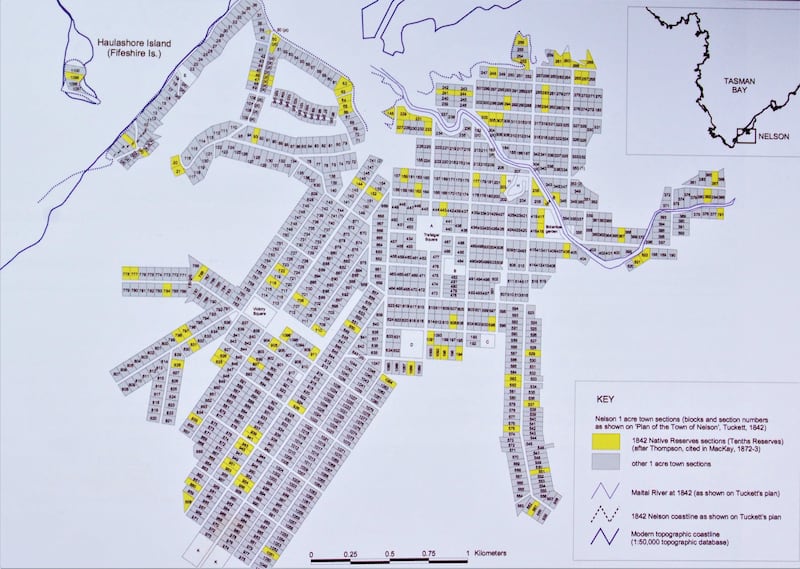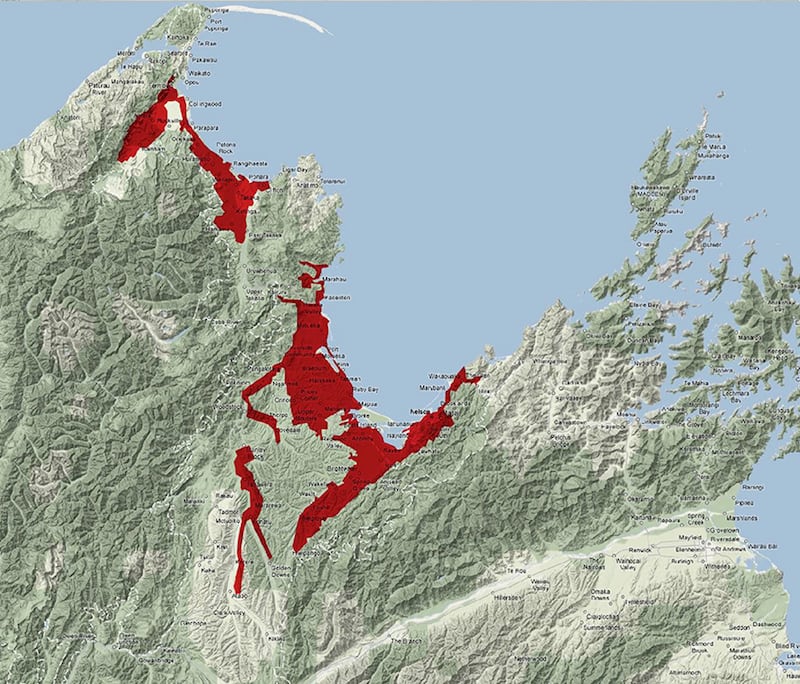The names of hundreds of early settlers are enshrined in a large plaque along Nelson’s gentle waterfront.
The hardships experienced on the journey from England on creaky and sometimes disease-infested sailing ships are captured in the steely stares of the ghostly figures in a nearby statue.
Further down the road, an equally steely depiction of Dutch seafarer Abel Janszoon Tasman - the first European explorer to set eyes on this country in 1642, stares longingly out across Tasman Bay from his plinth in a public carpark.
Afterwards, there was French explorer Jules Sebastien Cesar Dumont d’Urville, who in 1827 sailed into the region. His legacy is not in statues but in the names of various bays, islands and waterways in and around Tasman Bay.
Captain James Cook had only decades earlier sailed right on by, preferring the cool green anchorages of what would become the Marlborough Sounds.
There is nothing on the waterfront marking the arrival in Whakatū (Nelson) of the first Māori during the migration of tribes mainly from the North Island to Te Tau Ihu o Te Waka-a-Māui – the top of the South Island, centuries before European and English settlers arrived.

The stories that shaped this corner of the country, which is home to eight tangata whenua tribes, have gradually been unearthed by the long-running fight to resolve grievances over broken promises during land purchase deals by colonists.
The London-based New Zealand Company arrived in 1839 and began buying land for the Nelson settlement in the early 1840s. The settlement was enshrined in a legal deed by way of a Crown grant but deeds written in ink over land promised to be retained for Māori were soon smudged.
Local Māori began challenging the transactions in petitions raised but failed to get answers.
Now, 180 years on, the finish line is in sight following a Supreme Court decision in 2017 that the Crown had a duty to honour the original agreement to reserve 15,100 acres of land as the Nelson Tenths Reserves during settlement.
The court, by a four-to-one majority, also found the original agreement to reserve and protect local Māori papakāinga and other significant cultural lands had to be honoured.
It then handed the baton back to the High Court to determine the extent of the Crown’s breaches, any defences it had and remedies.
Nelson-based Wakatū Incorporation has been leading the case on behalf of the Māori customary landowners and hopes this next High Court matter will be the final hurdle towards resolution.
Wakatū chief executive, Kerensa Johnston (Ngāti Tama, Ngāruahine and Ngāti Whāwhakia) says that fundamentally they’ve applied the same argument as anyone might today over property protection laws.
“There are parallels that we could draw from then and today’s property transactions and it’s what Wakatū tried to do throughout the proceedings.
“We said, ‘just keep applying the same law that you’d apply to any breach of trust situation where there are clear legal obligations that need to be fulfilled’,” Johnston says.
What they want is for the Crown to restore the mana of Ngā Uri (ancestral connections) by settling, rather than continued delays through court processes; for the Crown to honour its legal duties by returning the land it holds and which ought to be part of the Nelson Tenths Reserves, and compensation for losses caused by the breach of obligations.
“We feel as if we got a really robust decision from the Supreme Court in 2017, in that the Crown has certain legal duties that have to be fulfilled in relation to the Nelson settlement.
“There’s not a lot of ambiguity in terms of what was promised.”

Johnston says it’s now up to the High Court to deal with the outstanding issues: the remedies available, the extent of the Crown’s breaches, and whether there are any defences available the Crown may wish to argue.
Wakatū is funding the legal case, which does not involve private land, just land held by the Crown. Neither is it a Treaty claim but one that has traversed the courts over decades as a private breach of trust.
Johnston says they had hoped the Supreme Court decision in 2017 might have ended the need for more trips to court.
“Our preference following that decision would have been to sit down and resolve the matter with the Crown and responsible ministers directly, and not be drawn back into litigation - which by its nature and is not without risk, but that hasn’t happened so we’re back in the High Court.”
At the heart of the matter is the arrival of the New Zealand Company in 1839 to buy land for its planned colonisation scheme.
Wakatū says an integral part of the company’s scheme was that one-tenth of the land it bought for any settlement would be set aside and held in trust for the customary Māori landowners.
All land occupied by Māori (pā, urupā and cultivations) was to be excluded from the sale.
This was officially recognised by Commissioner William Spain and became enshrined in the Crown grant of 1845.
But the agreement was never honoured. Only 5100 acres of what should have been 15,100 acres of land set aside were ever identified and reserved.
By 1882 the 5100 acres were whittled down to 3000 with the arrival of more settlers.
Currently, the customary Māori landowners have less than 20 per cent of the land they’re legally entitled to.
As Nelson historians, researchers and authors Hilary and the late John Mitchell said in their first volume of a tome on the history of Māori of Nelson and Marlborough: “It is a tragedy that such a well-intentioned concept as the New Zealand Company’s Native Tenths Reserves scheme was subverted and used by governments and government-appointed agents to cause such damage and destruction to the tangata whenua of Nelson, who entered the arrangement in good faith.”

The remnants of the tenths were held in trust and managed by the Crown and its trustees from 1845 until 1977 when the Wakatū Incorporation was formed by Māori landowners to receive and manage these leftovers.
Johnston says redress sought now is a combination of the proportion owed and land already tagged.
“The reason is that two things happened from the outset, from the point of time that the scheme was put into place in the 1840s, some Nelson Tenths were reserved, particularly in the Nelson CBD for example.”
It’s here that 100 one-acre sections were reserved as tenths, but in 1845 there was a remodelling of the town and 47 of those sections were removed from the trust and re-allocated primarily to NZ Company settlers.
“The other component of the case focuses on the land that should have been reserved but never was.”
Johnston says, for example, 10,000 acres of rural land in the Moutere, Motueka and some in Golden Bay were supposed to be reserved as tenths land. She says the Crown acknowledged the breach before the Supreme Court decision.
Wakatū says its whānau have argued the case in some form, from government petitions to court proceedings, for more than 180 years.
The current court proceedings began in 1986 - not a long time in the wider scheme of things, Johnston says.
Kaumātua Rore Stafford is fronting the High Court case, as representative of the Māori customary landowners - the descendants of those tūpuna identified by the Native Land Court in 1892.
Johnston, who joined Wakatū in 2012 as general counsel before she was appointed its CEO in 2016 says for her personally, the Nelson tenths had always been a critical piece of work that had run alongside all the other work done by Wakatū in the region.

She wouldn’t be drawn on cost, other than to say it had been “significant’, not so much in financial terms but in time and energy.
“There are other things we’d like to be focusing on for our family but this is fundamental in terms of a matter we believe strongly needs to be resolved.”
Today, Wakatū represents the interests of about 4000 owners, who descend from the customary Māori landowners, the whānau and hapū of the Whakatū (Nelson), Motueka and Mōhua (Golden Bay) rohe.
Since 1977 it has grown from having an asset base worth about $11 million to a current value of more than $350m, mostly in land and water space.
The hearing, which starts on Monday in the Wellington High Court, is expected to run for 10 weeks.
Crown Law is representing Attorney-General David Parker as respondent.
NZME has approached the Attorney-General’s office for comment but it declined as the matter was before the court.



